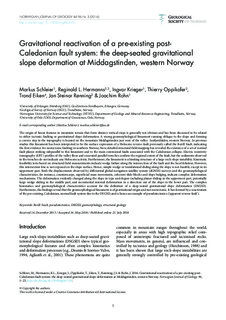| dc.description.abstract | The origin of linear features in mountain terrain that form distinct vertical steps is generally not obvious and has been discussed to be related
to either tectonic faulting or gravitational slope deformation. A strong geomorphological lineament running oblique to the slope and forming
a convex step in the topography is located on the mountain Middagstinden just west of the valley Innfjorddalen, western Norway. In previous
studies this lineament has been interpreted to be the surface expression of a Holocene reverse fault previously called the Berill Fault, indicating
the first evidence for neotectonic faulting in southern Norway. Now, detailed structural field mapping has revealed the existence of a set of normal
fault planes striking subparallel to this lineament and to the main extensional faults associated with the Caledonian collapse. Electric resistivity
tomography (ERT) profiles of the valley floor and excavated parallel trenches confirm the regional extent of the fault, but the sediments observed
in the trenches do not indicate any Holocene activity. Furthermore, the lineament is a limiting structure of a large rock-slope instability. Kinematic
feasibility tests based on structural field measurements indicate wedge failure along the intersection of the fault and the local foliation. However,
this intersection line is not exposed on the slope surface. Hence, simple wedge or translational sliding along the slope is not feasible, except in its
uppermost part. Both the displacements observed by differential global navigation satellite system (dGNSS) surveys and the geomorphological
characteristics, for instance, counterscarps, superficial mass movements, coherent slide blocks and slope bulging, indicate complex deformation
mechanisms. The deformation evidently changed along the slope in type and degree including planar sliding in the uppermost part, potentially
large wedge sliding in the middle part, and incremental internal deformation in a direction out of the slope in the lower part. The complex
kinematics and geomorphological characteristics account for the definition of a deep-seated gravitational slope deformation (DSGSD).
Furthermore, the findings reveal that the geomorphological lineament is of gravitational origin and not neotectonic. It has formed by a reactivation
of the pre-existing, Caledonian, normal fault system due to the DSGSD, and is hence an example of pseudotectonics ('apparent reverse fault'). | nb_NO |

